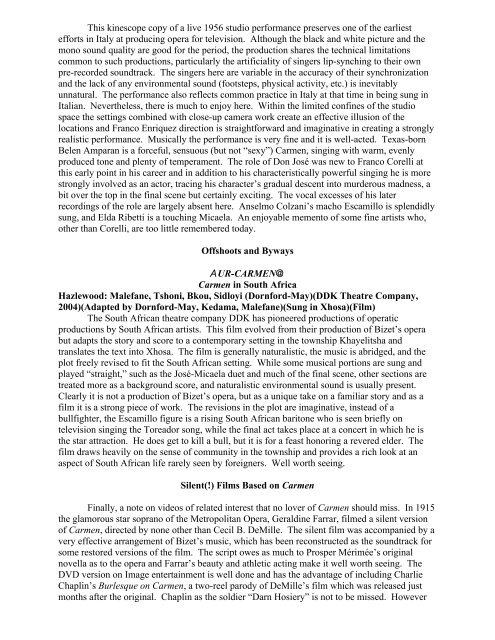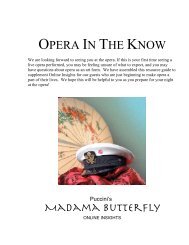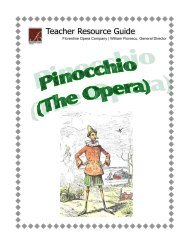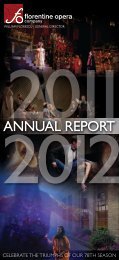1. Carmen on DVD--Complete Review(EDITED) - Florentine Opera
1. Carmen on DVD--Complete Review(EDITED) - Florentine Opera
1. Carmen on DVD--Complete Review(EDITED) - Florentine Opera
Create successful ePaper yourself
Turn your PDF publications into a flip-book with our unique Google optimized e-Paper software.
This kinescope copy of a live 1956 studio performance preserves <strong>on</strong>e of the earliest<br />
efforts in Italy at producing opera for televisi<strong>on</strong>. Although the black and white picture and the<br />
m<strong>on</strong>o sound quality are good for the period, the producti<strong>on</strong> shares the technical limitati<strong>on</strong>s<br />
comm<strong>on</strong> to such producti<strong>on</strong>s, particularly the artificiality of singers lip-synching to their own<br />
pre-recorded soundtrack. The singers here are variable in the accuracy of their synchr<strong>on</strong>izati<strong>on</strong><br />
and the lack of any envir<strong>on</strong>mental sound (footsteps, physical activity, etc.) is inevitably<br />
unnatural. The performance also reflects comm<strong>on</strong> practice in Italy at that time in being sung in<br />
Italian. Nevertheless, there is much to enjoy here. Within the limited c<strong>on</strong>fines of the studio<br />
space the settings combined with close-up camera work create an effective illusi<strong>on</strong> of the<br />
locati<strong>on</strong>s and Franco Enriquez directi<strong>on</strong> is straightforward and imaginative in creating a str<strong>on</strong>gly<br />
realistic performance. Musically the performance is very fine and it is well-acted. Texas-born<br />
Belen Amparan is a forceful, sensuous (but not “sexy”) <str<strong>on</strong>g>Carmen</str<strong>on</strong>g>, singing with warm, evenly<br />
produced t<strong>on</strong>e and plenty of temperament. The role of D<strong>on</strong> José was new to Franco Corelli at<br />
this early point in his career and in additi<strong>on</strong> to his characteristically powerful singing he is more<br />
str<strong>on</strong>gly involved as an actor, tracing his character’s gradual descent into murderous madness, a<br />
bit over the top in the final scene but certainly exciting. The vocal excesses of his later<br />
recordings of the role are largely absent here. Anselmo Colzani’s macho Escamillo is splendidly<br />
sung, and Elda Ribetti is a touching Micaela. An enjoyable memento of some fine artists who,<br />
other than Corelli, are too little remembered today.<br />
Offshoots and Byways<br />
AUR-CARMEN@<br />
<str<strong>on</strong>g>Carmen</str<strong>on</strong>g> in South Africa<br />
Hazlewood: Malefane, Tsh<strong>on</strong>i, Bkou, Sidloyi (Dornford-May)(DDK Theatre Company,<br />
2004)(Adapted by Dornford-May, Kedama, Malefane)(Sung in Xhosa)(Film)<br />
The South African theatre company DDK has pi<strong>on</strong>eered producti<strong>on</strong>s of operatic<br />
producti<strong>on</strong>s by South African artists. This film evolved from their producti<strong>on</strong> of Bizet’s opera<br />
but adapts the story and score to a c<strong>on</strong>temporary setting in the township Khayelitsha and<br />
translates the text into Xhosa. The film is generally naturalistic, the music is abridged, and the<br />
plot freely revised to fit the South African setting. While some musical porti<strong>on</strong>s are sung and<br />
played “straight,” such as the José-Micaela duet and much of the final scene, other secti<strong>on</strong>s are<br />
treated more as a background score, and naturalistic envir<strong>on</strong>mental sound is usually present.<br />
Clearly it is not a producti<strong>on</strong> of Bizet’s opera, but as a unique take <strong>on</strong> a familiar story and as a<br />
film it is a str<strong>on</strong>g piece of work. The revisi<strong>on</strong>s in the plot are imaginative, instead of a<br />
bullfighter, the Escamillo figure is a rising South African barit<strong>on</strong>e who is seen briefly <strong>on</strong><br />
televisi<strong>on</strong> singing the Toreador s<strong>on</strong>g, while the final act takes place at a c<strong>on</strong>cert in which he is<br />
the star attracti<strong>on</strong>. He does get to kill a bull, but it is for a feast h<strong>on</strong>oring a revered elder. The<br />
film draws heavily <strong>on</strong> the sense of community in the township and provides a rich look at an<br />
aspect of South African life rarely seen by foreigners. Well worth seeing.<br />
Silent(!) Films Based <strong>on</strong> <str<strong>on</strong>g>Carmen</str<strong>on</strong>g><br />
Finally, a note <strong>on</strong> videos of related interest that no lover of <str<strong>on</strong>g>Carmen</str<strong>on</strong>g> should miss. In 1915<br />
the glamorous star soprano of the Metropolitan <strong>Opera</strong>, Geraldine Farrar, filmed a silent versi<strong>on</strong><br />
of <str<strong>on</strong>g>Carmen</str<strong>on</strong>g>, directed by n<strong>on</strong>e other than Cecil B. DeMille. The silent film was accompanied by a<br />
very effective arrangement of Bizet’s music, which has been rec<strong>on</strong>structed as the soundtrack for<br />
some restored versi<strong>on</strong>s of the film. The script owes as much to Prosper Mérimée’s original<br />
novella as to the opera and Farrar’s beauty and athletic acting make it well worth seeing. The<br />
<strong>DVD</strong> versi<strong>on</strong> <strong>on</strong> Image entertainment is well d<strong>on</strong>e and has the advantage of including Charlie<br />
Chaplin’s Burlesque <strong>on</strong> <str<strong>on</strong>g>Carmen</str<strong>on</strong>g>, a two-reel parody of DeMille’s film which was released just<br />
m<strong>on</strong>ths after the original. Chaplin as the soldier “Darn Hosiery” is not to be missed. However








